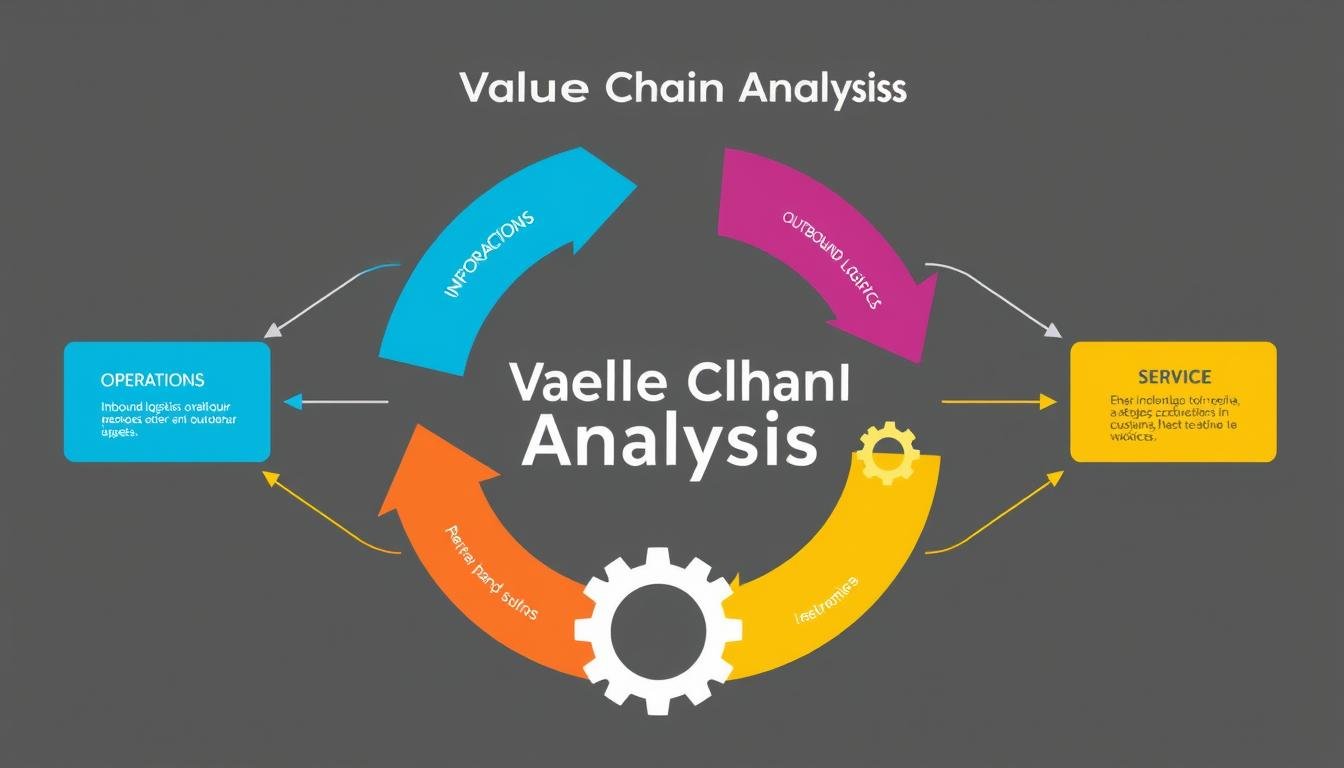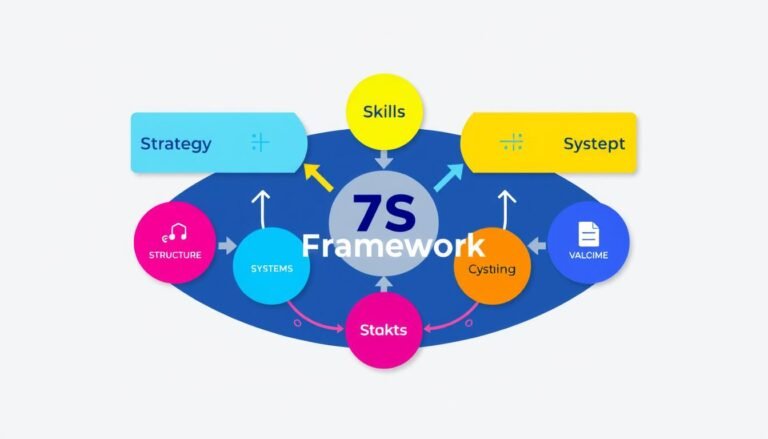Value Chain Analysis: Boost Your Business Strategy
Ever wondered why some companies do better than others, even if they sell the same products? The answer often is in their detailed use of Value Chain Analysis. This strategy helps businesses break down their operations into a clear value chain framework. It shows how every step adds to the overall value.
By knowing the value of each part of their chain, companies can find new ways to work better and make more money.
Key Takeaways
- Primary activities are key for adding value and include things like getting materials, making products, selling them, and after-sales service.
- Support activities, like buying materials and managing people, make the primary activities run smoother.
- Value Chain Analysis helps find ways to cut costs and make products stand out.
- Companies use this analysis to make better decisions and make customers happier.
- Doing a value chain analysis can greatly improve profits.
- By making their value chain better, companies can get ahead of the competition.
Understanding the Value Chain
The value chain is key to modern business strategy. Michael E. Porter introduced it in 1985. It helps analyze the activities that add value to products or services.
The idea is to break down the elements of the value chain. This lets companies find ways to improve and optimize their processes.
Definition of the Value Chain
The value chain includes all steps that add value to a product or service from start to finish. These steps cover material sourcing, production, distribution, and after-sales support. Knowing this helps companies spot where they can do better and align with their goals.
Importance of Value Chain Activities
Activities in the value chain are key to staying ahead. By sorting these into primary and support activities, companies can see where to cut costs or boost efforts. For example, looking at logistics and operations can save money and make things run smoother.
The framework also pushes businesses to check their tech and buying strategies. This ensures they stay competitive in cost and product uniqueness.
| Activity Type | Examples | Focus Areas |
|---|---|---|
| Primary Activities | Investing, Operations, Marketing, Service | Cost efficiency, Quality enhancement |
| Support Activities | Technology Development, Human Resources, Infrastructure | Streamlining processes, Enabling core activities |
What Is Value Chain Analysis?
Value chain analysis is a key tool for businesses to check their inner workings. It looks at all the steps that add value for customers. By closely examining these steps, companies can find areas to improve and boost performance and customer happiness.
Evaluating Business Activities
It’s crucial to see what makes a product valuable to customers. Harvard Business School’s Michael Porter says these activities are the core of a company’s edge. They fall into two main areas: being cheaper and offering something unique.
Walmart leads in being cost-effective, offering low prices. On the other hand, Starbucks and Apple focus on being different, which lets them charge more. This shows how different strategies can work.
Types of Value Chain Analysis
There are two main ways to do value chain analysis. One focuses on cutting costs across all steps, which boosts profits. The other is about making products stand out, which can lead to higher prices.
Both methods need a deep look at what makes a company tick and how it compares to others. Understanding this helps in making smart choices.
| Type of Advantage | Example Companies | Focus |
|---|---|---|
| Cost Advantage | Walmart, McDonald’s | Reducing costs to achieve lower pricing |
| Differentiation Advantage | Starbucks, Apple | Unique features to justify premium prices |
Using value chain analysis can spark new ideas and make operations smoother. It also helps meet goals for the environment, society, and governance. This method is useful for all kinds of businesses, helping them succeed in a lasting way.
Key Components of a Value Chain
The value chain model helps businesses understand how to deliver products and services well. It divides activities into primary and support types. Each type is crucial for making value. Looking closely at these parts shows how companies can get ahead.
Primary Activities
Primary activities directly help make and deliver products or services. They include:
- Inbound Logistics: This is about getting and storing materials.
- Operations: It’s the process of turning raw materials into finished goods.
- Outbound Logistics: This is about getting products to customers.
- Marketing and Sales: These are ways to promote and sell products.
- After-Sales Services: This is support given to customers after they buy something.
Support Activities
Support activities make primary activities work better, building a strong base. They are:
- Procurement: Getting materials at good prices.
- Human Resource Management (HRM): Hiring, training, and growing staff.
- Technology Development: Research and innovation to improve products.
- Company Infrastructure: The structure and management of the company.
Primary and support activities together make a strong value chain. This not only improves how things run but also makes a company stand out in the market.
Value Chain Analysis: Benefits for Your Business Strategy
Doing a value chain analysis has many benefits for your business strategy. It helps make operations smoother and more efficient, which can increase profits. It also shows where you need to improve, helping you become better at what you do.
Improving Operational Efficiency
A value chain strategy makes your business run better by finding and cutting out waste. It looks at five main areas: getting materials, making products, shipping them, selling them, and providing services. By focusing on these areas, companies can save money and make more profit.
Enhancing Customer Satisfaction
Understanding what customers want is easier with a good value chain analysis. Companies can find ways to make their products and services stand out. This makes customers happier and more loyal, leading to more satisfaction.
Identifying Competitive Advantages
Value chain analysis is key to finding what makes your business unique. By looking at how different parts of your business work together, you can find ways to save money and add more value. This helps you grow and stay ahead in the market.
| Value Chain Activity | Benefits | Competitive Advantage |
|---|---|---|
| Inbound Logistics | Streamlining product delivery | Lower transportation costs |
| Operations | Reducing production costs | Quicker time-to-market |
| Outbound Logistics | Improving distribution | Enhanced customer accessibility |
| Marketing and Sales | Targeted campaigns | Differentiated positioning |
| Services | Superior customer support | Loyalty and retention |
Conclusion
Value chain analysis is key for businesses wanting to improve their strategies and work better. It helps companies understand the different parts that make up their value chain. This knowledge is crucial for making important decisions.
By looking closely at each part of the value chain, businesses can find areas that need work. This helps them make better strategies. It’s like fixing weak spots to make the whole thing stronger.
In a textile factory study, it was clear that keeping costs low is important. Cutting down on things like wages and power use can help. These steps are vital for making more money and selling products well.
Companies like Tata Motors show how a well-planned value chain can lead to success. They use smart ways to move goods and make them. As more companies use these methods, they get better at what they do. This makes customers happier and helps them stand out in the market.
So, focusing on the value chain is key for any business aiming for growth and success. It’s all about making sure each part of the business works well together.
Source Links
- What Is a Value Chain Analysis? 3 Steps | HBS Online
- Value chain analysis: Definition, examples, and strategies
- Value Chain: Definition, Model, Analysis, and Example
- Value Chain Analysis: What It Is and How to Use It
- The Straightforward Guide to Value Chain Analysis [+ Templates]
- What is a value chain? Definitions and characteristics
- What Is Value Chain Analysis? | IBM
- What Is Value Chain Analysis and How Do You Use It?
- What is a value chain and why is it important? | Definition from TechTarget
- Value Chain Analysis: Advantages and Disadvantages
- Everything You Need to Know About Value Chain Analysis | Smartsheet
- 6 advantages and disadvantages of value chain analysis | TechTarget
- Value Chain Analysis Conclusion – 892 Words
- Unlocking Value Chain Analysis for Strategic Growth







